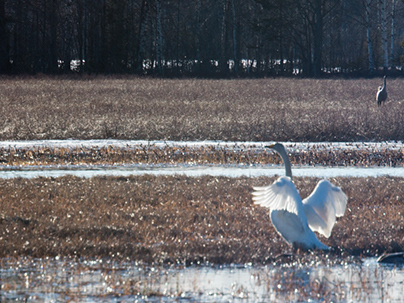Saint Lucy's Day - Ockelbo
Saint Lucy's Day Saint Lucy's Day, also called the Feast of Saint Lucy, is a Christian feast day celebrated on December 13 in Advent, commemorating Saint Lucy, a 3rd-century martyr under the Diocletianic Persecution,[1] who according to legend brought "food and aid to Christians hiding in the catacombs" using a candle-lit wreath to "light her way and leave her hands free to carry as much food as possible".[2][3] Her feast once coincided with the Winter Solstice, the shortest day of the year before calendar reforms, so her feast day has become a festival of light [Falling within the Advent season, Saint Lucy's Day is viewed as an event signaling the arrival of Christmastide, pointing to the arrival of the Light of Christ in the kalendar, on Christmas Day. Saint Lucy’s Day is celebrated most commonly in Scandinavia, with their long dark winters, where it is a major feast day, and in Italy, with each emphasising a different aspect of the story. In Scandinavia, where Saint Lucy is called Sankta Lucia in Swedish, she is represented as a lady in a white dress and red sash with a crown or wreath of candles on her head. In both Norway and Sweden, girls dressed as Lucy carry rolls and cookies in procession as songs are sung. Boys participate in the procession as well, playing different roles associated with Christmas. It is said that to vividly celebrate Saint Lucy's Day will help one live the long winter days with enough light. A special devotion to Saint Lucy is practiced in the Italian regions of Lombardy, Emilia-Romagna, Veneto, Friuli Venezia Giulia, Trentino-Alto Adige, in the north of the country, and Sicily, in the south, as well as in Croatian coastal region of Dalmatia. In Hungary and Croatia, a popular tradition on Saint Lucy's Day involves planting wheat grains that will eventually be several centimetres high on Christmas, representing the Nativity. An inscription in Syracuse dedicated to Euskia mentioning St Lucy's Day as a local feast dates back to the 4th century A.D., which states "Euskia, the irreproachable, lived a good and pure life for about 25 years, died on my Saint Lucy's feast day, she for whom I cannot find appropriate words of praise: she was a Christian, faithful, perfection itself, full of thankfulness and gratitude".[9] The Feast of Saint Lucy became a universal feast of the Church in the 6th century, commemorating the Christian martyr's death on 13 December 304 A.D.[10][11][12] St. Lucy's Day appears in the sacramentary of Gregory, as well as that of Bede, and Christian churches were dedicated to Saint Lucy in Italy as well as in England.[10][11] Later, Christian missionaries arrived in Scandinavia to evangelize the local population, carrying the commemoration of Saint Lucy with them, and this "story of a young girl bringing light in the midst of darkness no doubt held great meaning for people who, in the midst of a North Sea December, were longing for the relief of warmth and light".[7] Saint Lucy is one of the few saints celebrated by the overwhelmingly Lutheran Nordic people — Danes; Swedes; Finns and Norwegians but also in USA and Canada and Italy. It is speculated that the St. Lucy's Day celebrations in Scandinavia alone may retain a few indigenous Germanic pagan, pre-Christian midwinter elements. Some of the practices associated with the Feast of Saint Lucy may predate the adoption of Christianity in that region, and like much of Scandinavian folklore and even religiosity, is centered on the annual struggle between light and darkness. The Nordic observation of St. Lucy is first attested in the Middle Ages, and continued after the Protestant Reformation in the 1520s and 1530s, although the modern celebration is only about 200 years old. It is likely that tradition owes its popularity in the Nordic countries to the extreme change in daylight hours between the seasons in this region. The pre-Christian holiday of Yule, or jól, was the most important holiday in Scandinavia and Northern Europe. Originally the observance of the winter solstice, and the rebirth of the sun, it brought about many practices that remain in the Advent and Christmas celebrations today. The Yule season was a time for feasting, drinking, gift-giving, and gatherings, but also the season of awareness and fear of the forces of the dark. In Scandinavia (as late as until the mid 18th century) this date was the longest night of the year, coinciding with Winter Solstice, this was due to the Julian Calendar being employed at that time.[13] The same can be seen in the poem "A Nocturnal upon S. Lucy's Day, Being the Shortest Day" by the English poet John Donne. While this does not hold for our current Gregorian calendar, a discrepancy of 8 days would have been the case in the Julian calendar during the 14th century, resulting in Winter solstice falling on December 13. With the original adoption of the Gregorian calendar in the 16th century the discrepancy was 10 days and had increased to 11 days in the 18th century when Scandinavia adopted the new calendar, with Winter solstice falling on December 9. It is very difficult to tell the exact date of the Winter solstice without modern equipment (although the Neolithic builders of the Newgrange monument seem to have managed it). The day itself is not visibly shorter than the several days leading up to and following it and although the actual Julian date of Winter solstice would have been on the December 15 or 14 at the time when Christianity was introduced to Scandinavia, December 13 could well have lodged in peoples mind as being the shortest day. The choice of 13 December as Saint Lucy's day, however, obviously predates the 8 day error of the 14th century Julian calendar. This date is attested in the pre-Tridentic Monastic calendar, probably going back to the earliest attestations of her life in the 6th and 7th centuries, and it is the date used throughout Europe. So, while the world changed from a Julian to a Gregorian calendar system—and hence acquired a new date for the Winter Solstice—St Lucy's Day was kept at December 13, and not moved to the 21. At the time of Saint Lucy's death, Winter solstice fell on December 21 and the date of the birth of Christ on the 25th. The latter was also celebrated as being the day when the Sun was born, the birthday of Sol Invictus, as can be seen in the Chronography of 354. This latter date was thought by the Romans to be the Winter solstice and it is natural to think of the sun being born that day. Early Christians considered this a likely date for their saviour's nativity, as it was commonly held that the world was created on Spring equinox (thought to fall on March 25 at the time), and that Christ had been conceived on that date, being born 9 months later on Winter solstice.[14] A Swedish source[15] states that the date of (Winter Solstice, St. Lucia, Lucinatta, Lucia-day, Lussi-mass ...) i.e. December 13, predates the Gregorian which implies that "Lucia's Day" was Dec 13 in the Julian Calendar, which is equal to December 21 in the Gregorian, i.e. now. Same source states use of the name "Little Yule" for the day, that it was among the most important days of the year, that it marked the start of Christmas month, and that with the move to the Gregorian calendar (in Sweden 1753) the date (not the celebration) "completely lost its appropriateness/significance". Info:Wikipedia
You may also like










